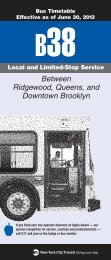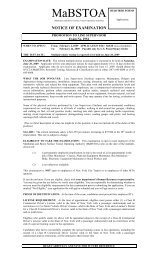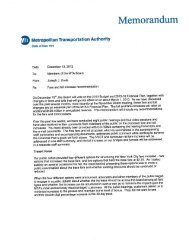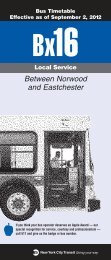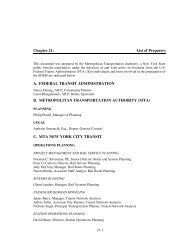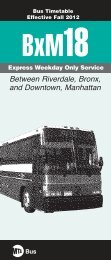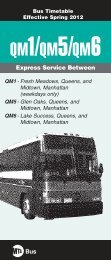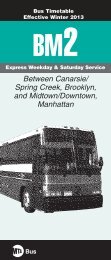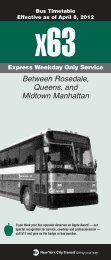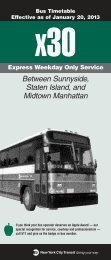Greening Mass Transit & Metro Regions: The Final Report - MTA
Greening Mass Transit & Metro Regions: The Final Report - MTA
Greening Mass Transit & Metro Regions: The Final Report - MTA
Create successful ePaper yourself
Turn your PDF publications into a flip-book with our unique Google optimized e-Paper software.
Recommendation 6. Increase Passenger Access at Stations<br />
To increase the capacity of train station parking lots, the <strong>MTA</strong> should expand the investment in parking programs and<br />
station access, adding spaces if possible, working closely with NYSDOT and NYS; the <strong>MTA</strong> should create more Park-and-<br />
Rides with feeder and connecting services. Incentivizing car pooling would also be beneficial, and the <strong>MTA</strong> should consider<br />
dedicating at least 5 to 10 percent of the best spaces for car-pool use only. Additionally, the <strong>MTA</strong> should consider the<br />
development of intermodal parking facilities at train stations. <strong>The</strong>se facilities will not only increase parking availability, they<br />
will coordinate transportation services, improve pedestrian/vehicular circulation and improve parking management. <strong>The</strong><br />
<strong>MTA</strong> should also review parking pricing as part of broader incentive strategies and expand facilities for those who want to<br />
bike to stations. Any investment in parking programs and station access should be part of a general strategy to discourage<br />
further sprawl.<br />
Recommendation 7. Improve the Integration of Stations into Communities<br />
<strong>The</strong> <strong>MTA</strong> should develop better integration of stations into the surrounding communities through improved facilities,<br />
bike and pedestrian access, and other station access plans. Train-to-trail linkages should be enhanced through collaboration<br />
with the New York State Office of Parks Recreation and Historic Preservation and local and regional organizations. <strong>The</strong><br />
<strong>MTA</strong> should explore a range of intermodal transportation services and links along <strong>MTA</strong> feeder corridors, including light<br />
rail, bus rapid transit, streetcars, bike facilities, and ferries. It should work with public or private partners to provide bus or<br />
other transit services linking stations to suburban villages or hamlets not on train lines, helping to increase more compact,<br />
efficient development.<br />
Recommendation 8. Support Bicycles as a <strong>Transit</strong> Link<br />
<strong>The</strong> <strong>MTA</strong> should play a prominent role in promoting cycling for commuters and recreational cyclists. <strong>The</strong> inclusion of<br />
bicycling as a mainstream mode of transportation has become a national objective, and the Commission recommends<br />
that it become a priority of the <strong>MTA</strong>.<br />
40<br />
Bicycles as a <strong>Transit</strong> Link<br />
To encourage and facilitate the use of bicycles as part of the <strong>MTA</strong><br />
passengers’ travel from point of origin to the final destination, the<br />
Working Group recommends that the <strong>MTA</strong>:<br />
• promote and facilitate bike parking at stations;<br />
• promote and facilitate bike transport on trains and buses;<br />
• promote and facilitate bike storage at <strong>MTA</strong> work sites;<br />
• provide consolidated and easily accessible bike information; and<br />
• act as an advocate and partner in promoting the use of bicycles<br />
as a sustainable link in urban and regional transit.<br />
See additional information on Biking as a <strong>Transit</strong> Link, prepared by<br />
Ned Sullivan, George Beane and the Smart Growth/TOD Working<br />
Group, in the Appendix of this report.<br />
<strong>MTA</strong> TA



